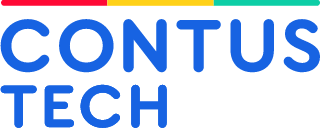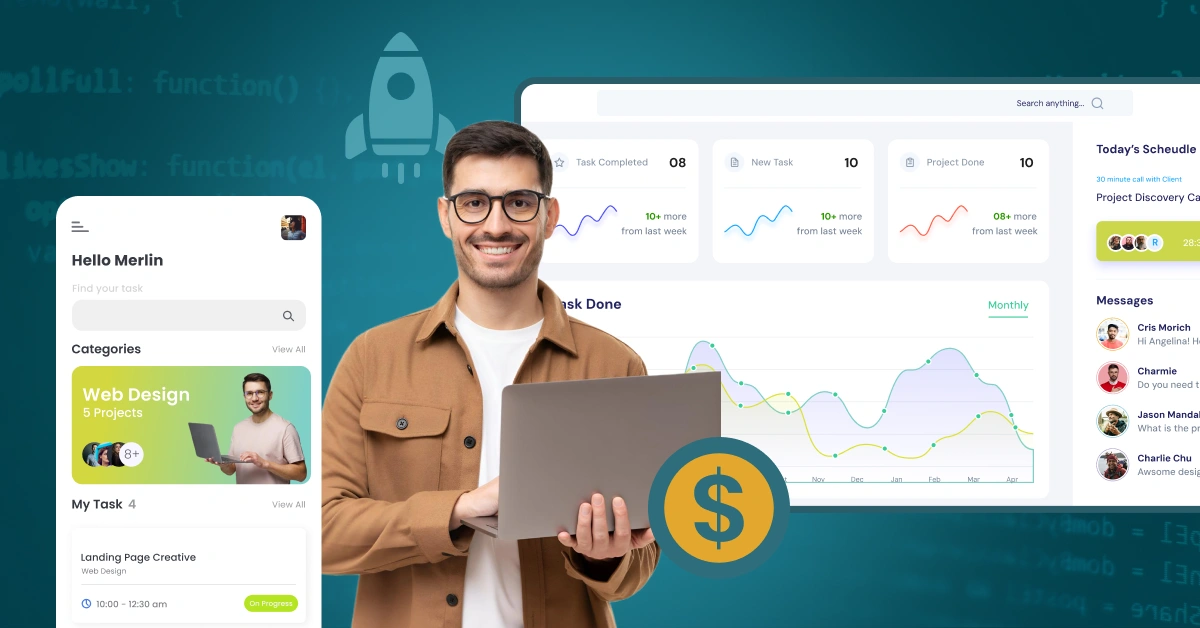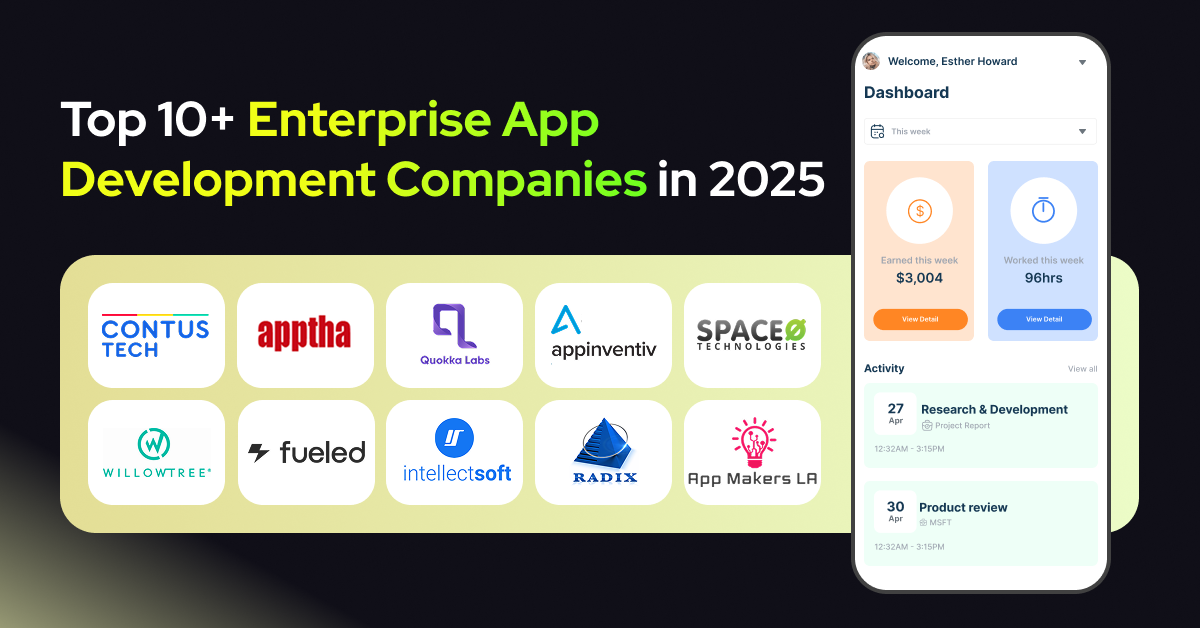How to Build an AI App: Step-by-Step AI Application Development Guide for 2026
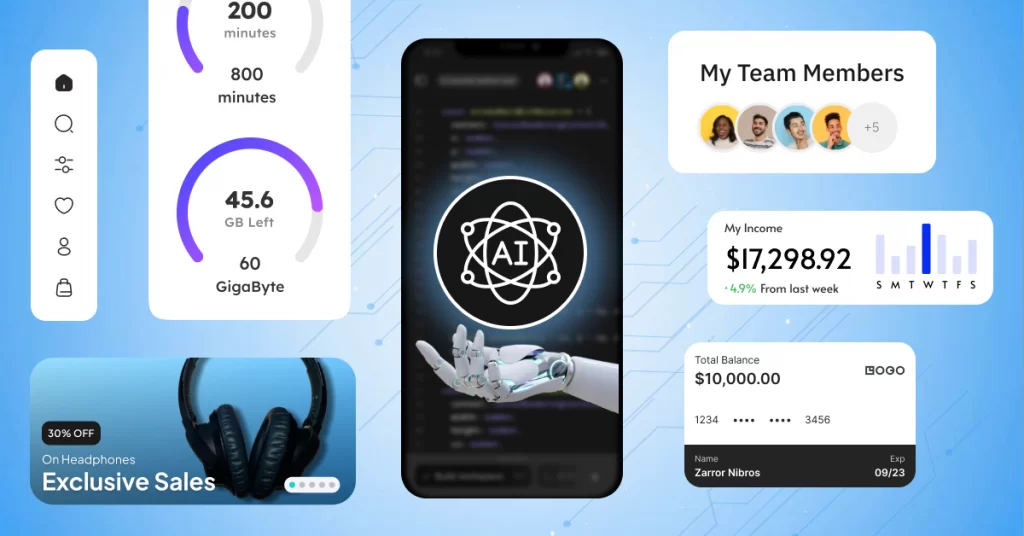
AI isn’t knocking on the door anymore, it has already moved in. Open any app today and you will see it quietly at work: curating playlists, answering support chats, sketching UI layouts, even writing chunks of code. AI application development has turned what once needed armies of developers into something that can be sparked by a single sentence fed to an AI model.
Just last year, “how to build app with AI” sounded like tech folklore, i.e., fascinating, but far-fetched. Fast-forward to 2026, AI is no longer just assisting development; it is co-creating apps alongside humans.
App builders are using AI to spin up wireframes, generate backend logic, and train models before their first coffee gets cold. And the numbers echo this shift. According to Statista, the AI market is projected to grow at a CAGR of 36.89% from 2025 to 2031, reaching an estimated value of USD 1.68 trillion by 2031.
So here is the real question: if AI can now help anyone build an app, how do you build one that stands out? This guide walks you through exactly how to build an AI app with speed, clarity, and strategy.
Table of Contents
How to Build an AI App: 8 Step-by-Step Process
When you start thinking about how to develop AI app solutions that actually work, know that it is less about luck and more about strategy. Just boilerplate coding won’t work; to bring profit, you need data-driven insights, and speaking of profits, here is a stat.
According to Stanford HAI, there’s been a revenue increase in 71% of companies that use AI for marketing, and 63% in supply chain management. You are so close to being one of those companies, and here are 8 steps on how to build an AI app.
These steps are not just for creating an app using AI from scratch; you can also rebuild your existing product by using the following steps.
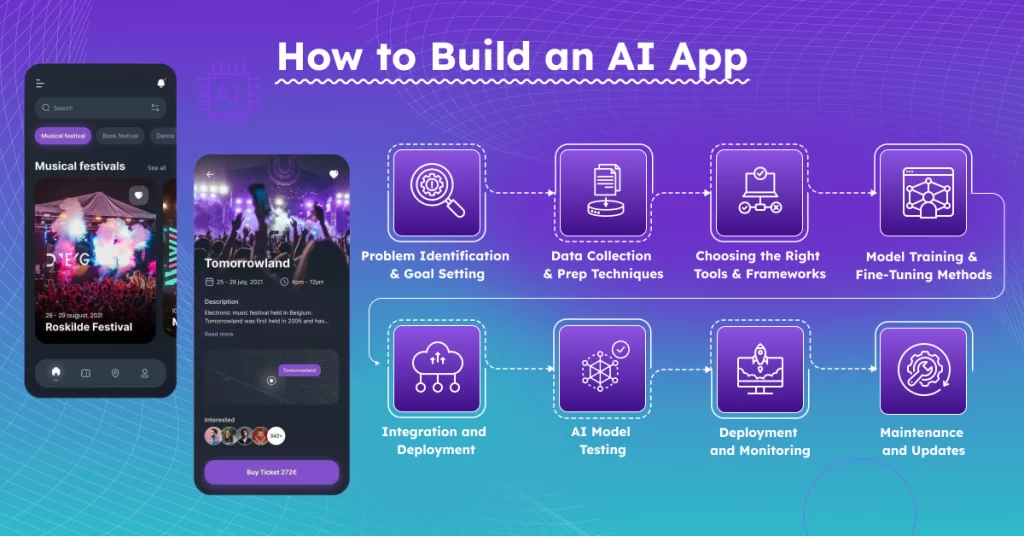
Here are the 8 focused steps to move from a spark of an idea to a working AI app with the help of AI development companies.
1️⃣ Define the Problem & Set Clear Objectives
Every winning app begins with one thing i.e., a problem statement. Before you burn cash on development, pause and ask: what real-world headache is this app solving, and where does AI genuinely fit in?
Are you automating tedious tasks, personalizing user journeys, or predicting behaviour like a pro? Start by mapping user pain points, collect brutally honest feedback (yes, even the stuff that stings), and figure out where AI can create real impact.
If you want to know how to create AI app for your business that users actually need, this clarity stage is non-negotiable. Otherwise, you will end up with an app no one asked for. Set specific, measurable goals: What KPIs will lead to success? What user actions should improve? These goals will anchor your scope, and keep your roadmap clear.
2️⃣ Gather and Prepare Quality Data
Once you have locked your app’s goal, start gathering relevant data from your internal tools, public repositories, third-party vendors, or honestly, anywhere credible you can get your hands on.
But collecting isn’t enough. Messy data is like hiring an intern without an orientation, chaos guaranteed. Clean it up; remove duplicates, fix formats, label things correctly, and split it neatly into training, validation, and test sets. This isn’t some glamorous work, but it is what decides whether your model is learning faster or not.
If you are thinking about how to make an app with AI in 2026, think ahead, maybe your app will need real-time data pipelines for continuous learning. Because at the end of the day, AI isn’t just about fancy models. It is about the ecosystem of data feeding them. Get that right, and everything else runs smoother.
3️⃣ Select the Right Tech Stack & Frameworks
Here is where many teams go on a full shopping spree. Downloading every framework that promises and ending up with a tech stack that is cluttered and confusing.
When you create an app with AI, resist that urge. Start by picking core languages and frameworks that match your app’s goals; not just what is trending on Twitter. If your AI app leans on natural language, look at LLM frameworks and NLP libraries. If it is heavy on predictions or analytics, look for ML toolkits/cloud AI services.
Also, don’t ignore infrastructure. Figure out where this AI app will go live (cloud, hybrid, or on-prem). Remember, scaling later is easier if you build smart today (and way cheaper than panic-rebuilding mid-launch). And please, choose tools your team actually understands. Cutting-edge tech is cool until no one on your dev team knows how to debug it.
4️⃣ Train and Fine-Tune Your AI Models
Until now it has just been theory and caffeine. This is the moment your app actually starts to think. You will take all that prepped data and train machine learning or deep learning models to spot patterns, make predictions, or spit out outputs that (hopefully) don’t embarrass you in the demo.
Training basically means running data through algorithms, adjusting weights, and watching the model learn. Expect multiple rounds of trial and error. You will tweak hyperparameters, experiment with model architectures, and probably borrow pre-trained models using transfer learning.
And if you are wondering how to create an AI app from scratch, here is the real cheat code: fine-tuning. It is how you take a general model and teach it your domain’s quirks, meaning the slang, the weird behaviours, the niche data patterns.
5️⃣ Integrate AI Into Your App Architecture
Now comes the most important step i.e., taking your trained AI brain and wiring it into your app without breaking everything else. This is where many founders panic, because suddenly it is not just models in a sandbox anymore. It is your actual product on the line.
In AI application development, this is the point where architecture decisions can make or break the entire experience. You can wrap your model as an API, plug it straight into your backend, or deploy it as a microservice floating gracefully in the cloud.
Whatever you choose, design your integration layer to survive traffic spikes and tantrums, because when your users arrive (and they will, right?) latency can kill the vibe.
Also, be deliberate about where AI shows up in your user journey. Place it where it solves a real user problem and feels native to the flow. When done right, it will just quietly do its job.
6️⃣ Test and Validate AI App Performance
Before you release your new AI app to real users (and pray nothing crashes), you need to grill your model. AI is not like regular code, it can behave unusual as well in real-world situations.
Start by running it against your reserved test set to check accuracy, precision, recall. Basically, see if it can actually walk the talk. Then throw edge cases and weird corner scenarios at it just to watch how it reacts. Because if your model breaks when a user does something slightly unexpected, then it would be of no use.
Also, don’t leave it to just your devs. Pull in domain experts to check the model’s output from a business angle. It is not enough that the math is correct, it has to make sense in your actual industry. This is the step that separates “ demo” from “real product” : skip it, and your users will happily find the bugs for you.
7️⃣ Launch with Continuous Monitoring
Finally, launch day. Once your AI app goes live, real work begins. Keep an eye on metrics like prediction accuracy, response latency, user engagement, and error rates. Because AI models age faster than you expect – data drifts, user behaviour changes, and suddenly your “smart” app is giving irrational answers.
Set up monitoring dashboards and automated alerts so you catch issues before users do (nothing kills brand trust faster than your AI giving wrong outputs). Treat deployment like a living, breathing process; keep feeding it new data, reviewing performance, and fine-tuning.
If you are figuring out how to build an AI app that actually lasts, remember that launch isn’t the victory lap, it is just the starting whistle.
8️⃣ Nurture Your AI App Continuously
Congrats, your AI app is live but wait for a moment because AI isn’t a ‘build once, chill forever’ deal. Think of it like that one houseplant you forgot to water: ignore it, and it will wither faster than your weekend plans.
Over time, retrain your models with fresh data, tweak algorithms, and roll out updates based on user feedback. This keeps your app from suffering concept drift. When predictions start going off-track because the real world moved on and your model didn’t.
Also, schedule regular audits for data quality, bias, and compliance (because regulators take things seriously). Make this upkeep part of your product roadmap from day one.
Top 5 Industries Where AI App Is Having an Impact Today
The Forbes CxO Growth Survey of 2025 has found that 93% of 1000 respondents, all of whom were C-suite executives, have reported to increase in their investment in AI over the next two years. Around 56% had planned to increase their AI budgets to 16% or more.
This shows that AI is quietly sneaking into every boardroom agenda (and profit charts right side up). If you are planning to create an app with AI, these sectors are already proof that it is not just hype.
➡️ Healthcare
A number of hospitals use AI apps to scan medical images for early disease detection and answer patient questions at 3 a.m.; the impact is massive.
According to a Forbes October 2025 stat, there has been a 22% increase in AI adoption across healthcare organizations, which is 7 times higher than in 2024 and 10 times higher than in 2023.
Hospitals are using AI-powered diagnostic tools to reduce human error, while pharma companies are using predictive models to slash R&D timelines.
If you are sort of figuring out how to build an AI app for this sector, keep in mind that accuracy, compliance, and speed are the most important.
➡️ FinTech
The finance world has completely stopped trusting gut instinct (and honestly, good call). In a November 2024 Forbes report, it was stated that 76% of financial services companies had launched AI initiatives.
But how to create AI app solutions that function seamlessly and deliver real impact is now rewriting how banks, NBFCs, and fintech startups operate. This includes fraud detection that flags shady transactions in milliseconds to robo-advisors serving personalized investment plans.
If you plan to build an app with AI here, remember: security and regulatory compliance are non-negotiables. Because nothing crashes faster than user trust in finance.
➡️ Entertainment
Entertainment players aren’t just producing content anymore; they are using AI to predict what you will binge next weekend before you even know it. Studios now create apps using AI to edit videos automatically, recommend shows, and even generate music scores or dialogue.
According to Grand View Research, AI in media and entertainment is projected to reach USD 99.48 billion by 2030, which is a CAGR increase of 24.2% from USD 25.98 billion in 2024, showing just how fast this space is growing.
If you are exploring how to create an app with AI in this space, think about hyper-personalization. Make the app feel like it is reading users’ minds, and you will have them hooked.
➡️ Education
Remember when education was just books, blackboards, and boredom? Yeah, AI blew that up. According to Forbes Advisor’s survey, 55% of teachers said that AI has a positive effect on the learning process and teaching, and 60% of them use AI in their classrooms.
Edtech companies are using AI to create apps that deliver adaptive learning, personalizing content based on how students perform. AI chatbots now answer student queries, grade papers, and offer real-time feedback.
Those planning to create an AI app for this sector must focus on engagement and scalability. Because nothing kills user interest faster than a dull app that can’t keep up with learning curves.
➡️ Hospitality
Hotels and travel brands are now quietly utilizing AI in their applications for adjusting room rates on the fly. In fact, the entire hospitality sector is utilizing AI bots to handle guest requests in the quickest time possible.
This rapid adoption is reflected in a study by Business Research Company, which found that AI in hospitality will reach $1.44 billion in 2029, a 57.6% CAGR from the market size of $0.15 billion in 2024.
If you are exploring how to make an AI app here, focus on user delight and operational efficiency. In hospitality, every second saved is a five-star review earned, and AI is the secret sauce making it happen.
Traditional Apps Vs AI-Powered Apps: Key Differences You Need To Know
When you decide to build an AI app, it is essential to understand how it stands out from the traditional apps that are available in the market. The traditional apps work on static rules while AI-enabled apps learn from data, change its behavior based on the environment, and make decisions on the fly.
If you are planning to create an app with AI or just exploring how to build an app with AI, we have simplified your process through the comparison below.
| Feature | Traditional Apps | AI-Powered Apps |
| Decision-Making | Static – can handle only programmed scenarios | Dynamic – can predict and make decisions based on previous patterns |
| User Experience | Same experience for all users | Customized and context-aware experiences |
| Data Handling | Limited to structured input | Handles large amount of structured and unstructured data |
| Automation | Performs tasks exactly as programmed | Automates complex tasks and enhance results over time |
| Adaptability | Need to update manually for new scenarios | Learns and improves constantly with new data |
| Examples | To-do apps, Banking apps | Chatbots, recommendation engines, smart assistants |
Understanding these differences becomes essential when you aim to develop an AI app. Traditional apps can be trustworthy for repetitive tasks but AI-powered apps offer flexibility and customization which improves customer engagement. You will be more equipped to build an AI app that is both useful and future-ready if you understand this difference.
Benefits of Developing AI Applications For Your Business
When you create an app with AI, you get to see measurable benefits, and here is a stat to prove that. According to an AIPRM survey, 43% of people state that AI increases productivity, 39.4% believe it improves decision-making, 30.8% say it improves customer relationships, and 25.3% state that it saves AI Development costs.
This shows why businesses choose to create apps with AI solutions that make everyday tasks easier and more effective for their teams.
✅ Personalized Experiences
One of the biggest perks when you create an app with AI is personalization. Unlike traditional apps that provide the same content to all users, AI apps learn from their actions, preferences, and interactions.
Grand View Research has found that AI-based personalization engines are projected to grow up to USD 717.79 billion by 2033 from the estimated USD 455.40 billion in 2024, a CAGR increase of 5.3%, showing just how important customization has become.
If you are looking for how to build an AI based app for your e-commerce site or for a streaming platform, customization lets your app provide products or content that are tailored to each user’s needs. Customized experiences increase user satisfaction and engagement by giving users exactly what they need.
✅ Automate The Boring Stuff
Knowing how to build AI apps is all about automating tasks that would typically take up your time and resources. From answering customer questions to analyzing massive datasets, AI apps act as dedicated team members that never call in sick.
This increases productivity and gives your staff more time to work on important and innovative projects. Automation is a game-changer for companies looking to create an app with AI since it speeds up processes and lowers human error.
✅ Make Smarter Decisions
Real-time data is one of the biggest assets in building an AI app. AI applications scan massive volumes of organized and unstructured data, identify trends, and make predictions faster than humans.
If you are forecasting market trends, learning how to create AI applications ensures that your decisions are data-driven and accurate.
✅ Accuracy and Reliability
One of the less-debated advantages of learning how to build AI software is the considerable reduction in errors. AI algorithms perform calculations, predictions, and execute processes with high accuracy. Such accuracy is essential in industries like healthcare and finance.
This increases user confidence and guarantees that your software will always produce reliable results.
✅ Cost Efficiency
AI applications help businesses save money and time. Businesses can efficiently deploy resources by automating repetitive work and eliminating errors. This allows teams to focus on higher-value tasks and strategic initiatives, increasing overall productivity.
A Forbes survey among marketers has found that AI has saved an average of $4,739 per month per team and 13 hours per person.
If you are exploring how to develop AI based apps, cost efficiency is one of the main advantages you can yield by embracing artificial intelligence.
✅ Keep Users Hooked
What makes your shopping experience interesting? The personal recommendations as per your interests, right? This is where AI apps let users engage in your app for a long time and make them buy your product.
If you’re wondering how to make AI applications interesting, AI application development companies can help you with it.
Key Elements of AI Application Development
The common key elements to build an AI app include machine learning, neural network, natural language processing, deep learning, computer vision, fuzzy logic, robotics, and expert systems.
If you are a business owner exploring AI application development, knowing how to develop AI application involves more than coding. Let’s take a look at all the important components of building AI.
📌 Machine Learning
Machine Learning is a pillar of AI app development. It enables systems to learn from data and adapt over time, and there is no need to program explicitly for every scenario. If you are developing an AI app for pattern recognition, data analysis, prediction, and automation, then Machine Learning is what you need.
Machine Learning methods include:
- Supervised learning: e.g., classifying product defects, fraud detection
- Unsupervised learning: e.g., grouping similar users, forecasting sales
- Reinforcement learning – e.g., personalized recommendations, dynamic pricing in eCommerce
📌 Natural Language Processing
NLP is the branch of artificial intelligence that enables natural language communication between humans and computers. This allows you to interact using your own language without having to write code.
For business owners exploring how to build an AI app, NLP keeps interactions smooth and intuitive. AI developers use an NLP library to develop AI applications like
- Content generation
- Virtual voice assistants and chatbots
- Sentiment analysis
📌 Deep Learning
If machine learning is the brain, deep learning is its cognitive relative. Deep learning analyzes enormous volumes of data using multi-layered neural networks to find patterns that are frequently hidden from view.
This is essential if you are looking for how to create a sophisticated app with artificial intelligence. Deep learning technique makes it easier for your app to identify intricate patterns in voice, faces, and even emotions.
📌 Computer Vision
Computer Vision allows AI to analyze real-time visual data like human vision to extract meaningful information from images and videos. This is what helps build AI applications like self-driving cars, complex medical image analysis, and quality control in manufacturing.
Many business owners consider creating an AI-based Android app with visual intelligence for areas like automated inspections and product quality verification.
If you want your AI to have a better understanding of the world, then include computer vision in your AI application development.
📌 Expert Systems
If you are wondering how to develop an app with AI that makes the right decisions for your business, you need Expert Systems. They replicate the decision-making strategies of humans. This is accomplished by applying reasoning and insight rules to the words of user queries after knowledge has been derived from its knowledge base.
They use heuristic knowledge to give outputs similar to the problem-solving capacities of humans. This makes it a critical component in AI app development.
Amazon’s product recommendation rule engine is an Expert System that operates based on rules + data patterns to suggest products to customers.
📌 Fuzzy Logic
You want to know how to build AI app that handles uncertainty, Fuzzy Logic is the answer. It gives nuanced outputs by interpreting data like humans. Its reasoning is very similar to humans and can easily manage complex systems and reduce the number of rules needed to manage them.
Gmail uses Fuzzy Logic to categorize spam and not spam emails, and makes a human-like filtering of emails rather than strict rule-based filters.
How CONTUS Tech Can Help to Build AI App
You would agree that building an AI app isn’t just about stitching together code and a pre-trained model; it is about aligning technology with real business goals.
That’s exactly where CONTUS Tech steps in. The company has expertise in custom AI software development services that helps businesses translate their ideas into fully functional, production-ready AI solutions.
So, how do we make AI app for Android? We start by understanding your industry, workflows, and end-user behavior. We will assess whether you are planning a diagnostic support system for healthcare, a fraud detection engine for fintech, or a recommendation algorithm for an entertainment platform, we design a solution blueprint that matches your operational realities.
Once the foundation is set, our team handles the entire lifecycle. This includes data engineering and model development to testing, deployment, and post-launch optimization. If your use case demands computer vision, NLP, predictive analytics, or generative AI, we integrate the right models and APIs.
Equally important, we focus on scalability and compliance from the start. That means your AI app can handle growth without breaking, and it adheres to industry regulations (like HIPAA for healthcare or PCI DSS for fintech) from day one.
By combining robust architecture with UX, our goal is to help you build AI app experiences that are intelligent, user-centric, and business-friendly. So whether you are launching a new product or modernizing an existing system, CONTUS Tech gives you the technical edge to make it happen.
FAQ’s About AI Application Development
1. What are the key benefits of implementing AI-powered apps in business operations?
Implementing AI-powered apps in business operations automates time-consuming, repetitive tasks which improves employee productivity and also reduces labor costs. It helps maintain high precision and consistency, better decision-making, and risk management.
2. What challenges are associated with AI development, and how can they be addressed?
Common challenges in AI development are quality and availability of data, bias and fairness, privacy and security, and the shortage of expertise. Such difficulties may be mitigated through investing in data cleaning, strong security measures, and AI training for the current staff.
3. How do testing, deployment, and monitoring in AI development ensure the accuracy and adaptability of AI-driven apps?
Data validation, bias identification, and testing measures such as precision, recall, and F1-score are used to ensure AI app accuracy. Also, well-planned strategies like regression and security testing, pre-deployment checks, controlled rollouts, and CI/CD integration maintain reliable performance.
4. What AI app development services does CONTUS Tech offer?
CONTUS Tech provides AI App development services, such as machine learning, Natural language processing, e.g,. semantic search and chatbot AI agent, computer vision, AI recommendation engine, chatbot, AI agent, generative AI, and domain-specific AI.
5. How does CONTUS Tech customize AI solutions for different industry verticals?
CONTUS Tech tailors AI solutions to various industry sectors via a systematic customization approach: discovery and planning, solution blueprint and PoC, exploiting machine learning and natural language processing, industry-specific compliance and security, and deployment and optimization, e.g., fraud detector in finance or appointment scheduler in health care.
Connect With Our Team, Discuss Your AI Application Development Requirements, and Begin Your Project in Just Next Few Days.
